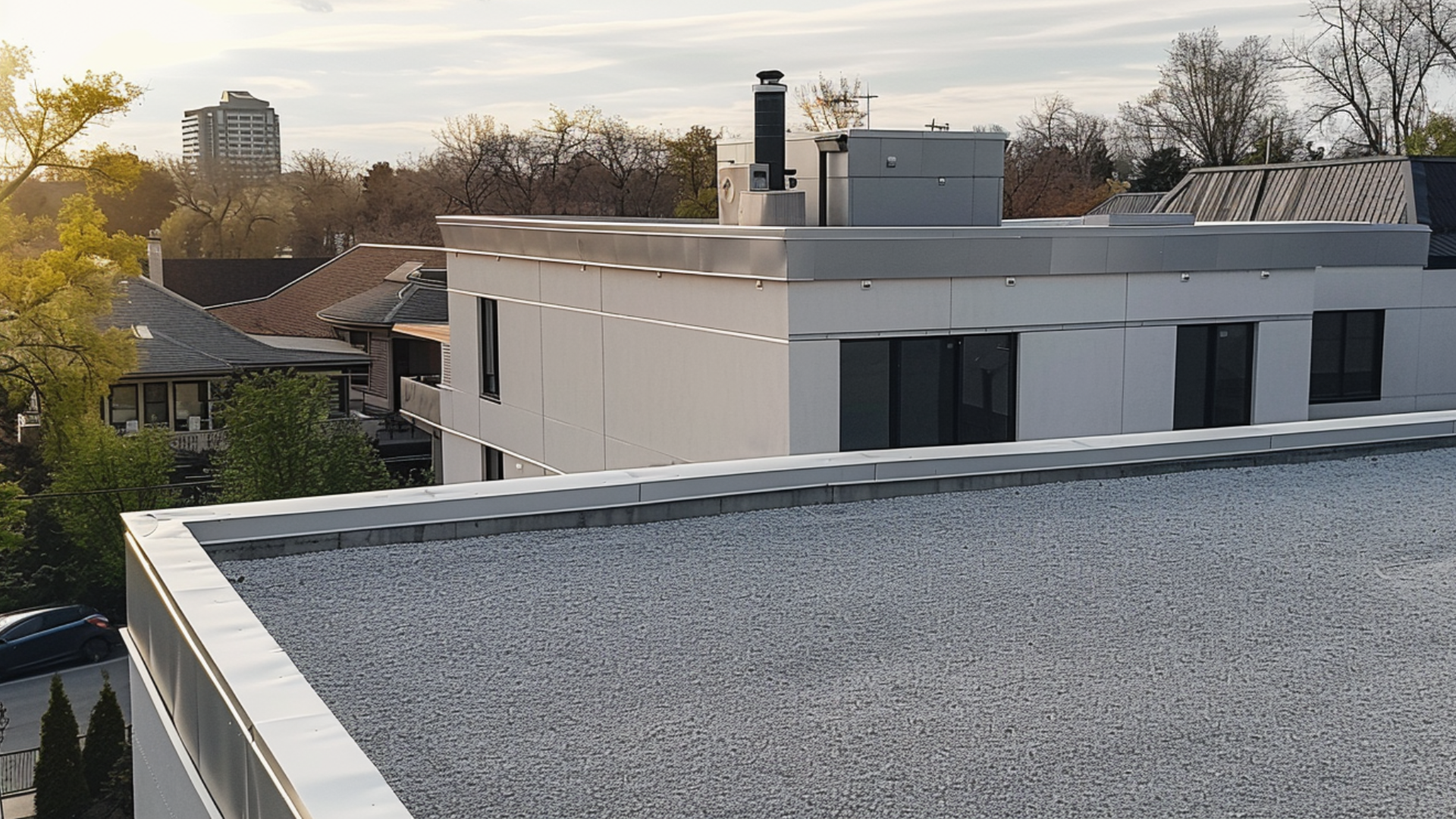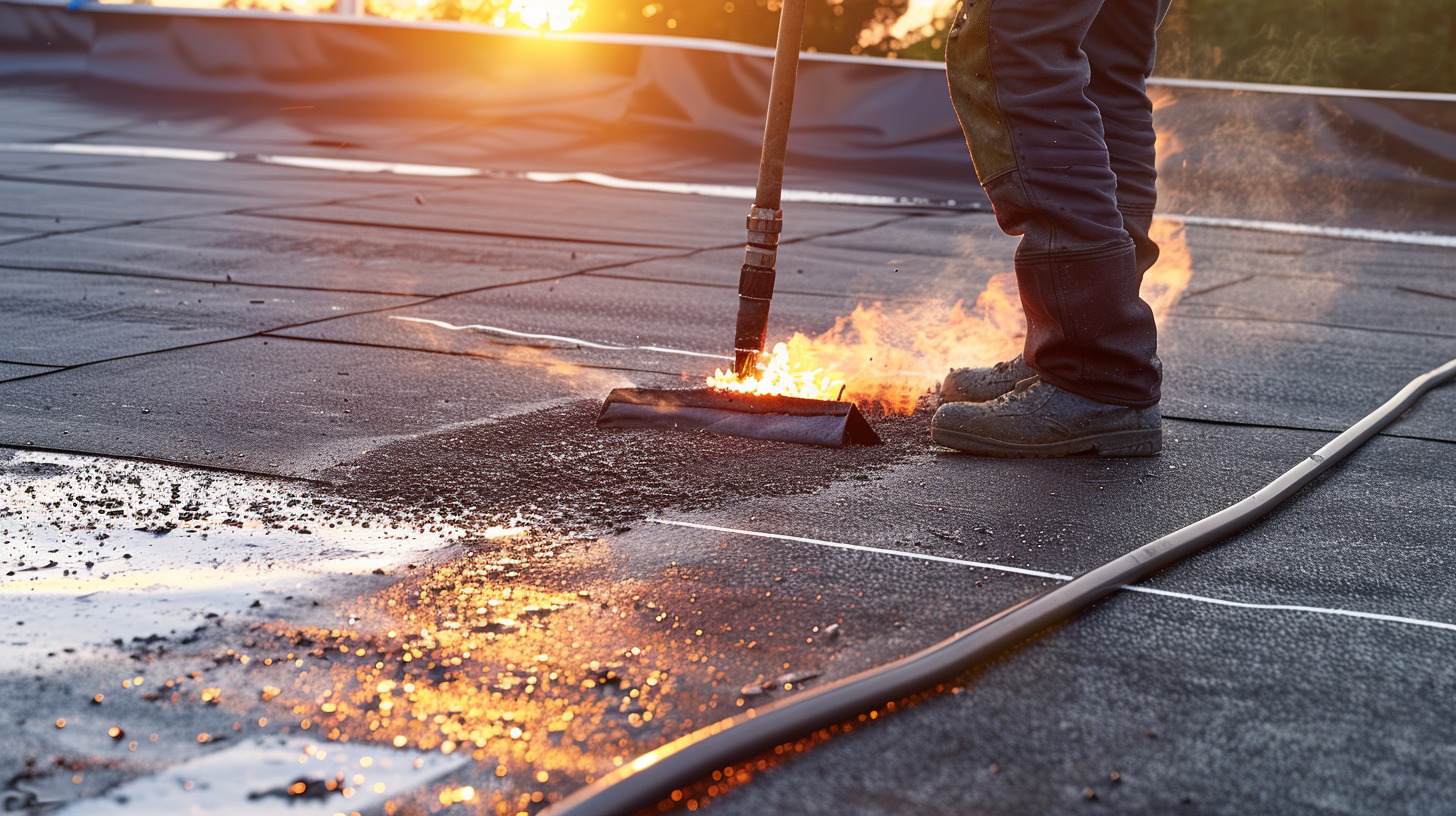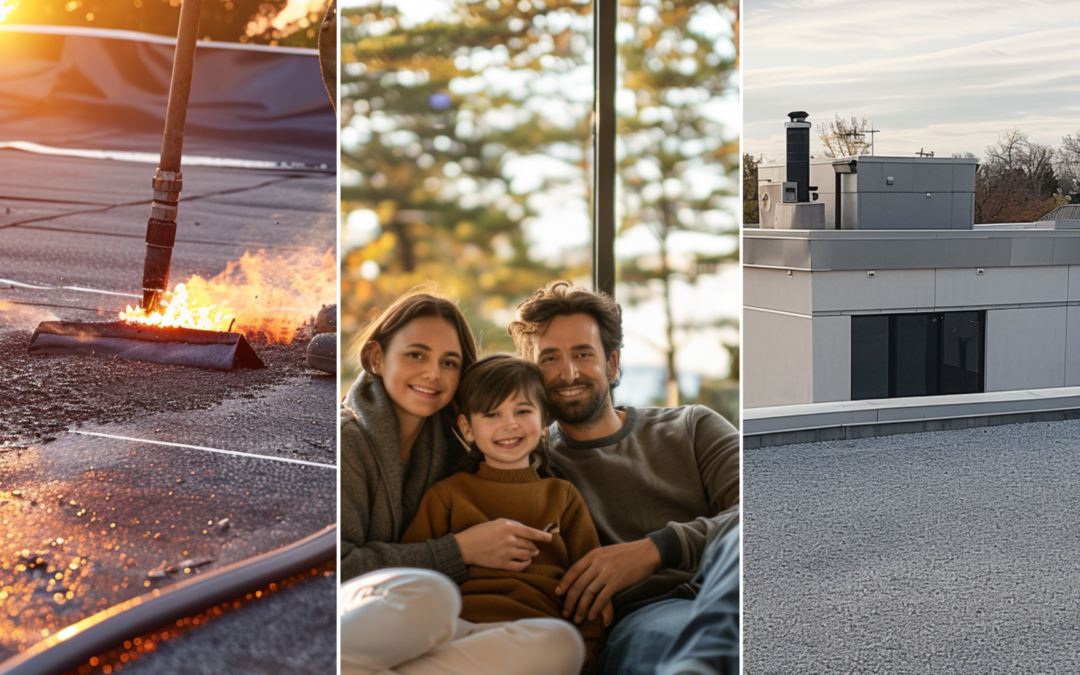Built-up roofing, or BUR, is a popular and reliable system used in commercial and industrial buildings. It comprises multiple bitumen or asphalt layers, alternating with reinforcing fabrics or felts. These layers are then bonded using a hot tar or asphalt adhesive, creating a strong and durable roof membrane. Built-up roofing systems have been used for over a century. They are a preferred choice for many property owners due to their longevity, weather resistance, and fire retardant properties. With proper installation and regular maintenance, a built-up roof can provide years of reliable protection for a building. In addition, they are versatile and can be modified to accommodate various configurations, slopes, and architectural designs.
History of Built-up Roofing
Built-up roofing, or BUR, has a rich history and significant importance in the roofing industry. In the mid-19th century, BUR was primarily developed to waterproof and protect low-slope roofs. Over time, BUR has evolved with the introduction of other low-slope roofing systems, although it remains a popular choice in many construction projects. Throughout its development, BUR has seen several key milestones and advancements in technology, such as the introduction of mechanically attached systems and the incorporation of fire-resistant materials. Various materials and techniques have been used in BUR over the years, including layers of asphalt-impregnated felts, bitumen, and gravel. These materials and techniques have contributed to the durability and longevity of BUR, making it a reliable choice for roofing construction.

Built-up Roofing - Components of Built-up Roofing Systems - Sky Roofing Construction & Remodeling
Components of Built-up Roofing Systems
Built-up roofing systems, also known as BUR systems, are a popular choice for both commercial roofing systems and residential buildings. These systems have various components that provide a durable and long-lasting roof. One essential component of a built-up roofing system is the base sheet, which serves as the foundation for the roofing system. The base sheet is typically made of fiberglass or organic materials and is designed to provide strength and stability. Another essential component is the ply or felts, which are layers of roofing material interlaid and bonded with asphalt or bitumen. These layers help create a waterproof barrier and strengthen the roof substrate. Finally, a top layer of gravel or mineral granules is applied to the roof’s surface, protecting against weathering and UV rays. With their multiple layers and vital components, built-up roofing systems offer exceptional durability and longevity, making them a reliable choice for any roofing project.
In a modified bitumen roofing system, there are two layers of bitumen known as the base sheet and the cap sheet. These layers and layers of insulation are applied to provide a durable and long-lasting roofing solution. The base sheet serves as the foundation layer, offering strength and stability to the roof. It is typically reinforced with fiberglass or polyester to enhance its durability. The cap sheet is the topmost layer, which protects the base sheet and provides an attractive finish.
Various methods can be used to apply the layers of bitumen, including torching, hot mopping, or cold adhesive application. Each technique offers its advantages depending on the specific project requirements. Different polymers, such as styrene-butadiene-styrene (SBS) or atactic polypropylene (APP), can be added to the bitumen to enhance its flexibility, weather resistance, and overall performance. These polymers contribute to the versatility and durability of the built-up roofing system.
The base sheet is a crucial component of built-up roof systems, providing a strong and durable foundation for the roof. It is typically made of organic or fiberglass felt and acts as a protective layer between the roof deck and the additional layers of the roofing system. The base sheet is vital in enhancing the roof’s overall structural integrity and protecting it against potential damage from weather elements such as rain, wind, and UV rays. Additionally, the base sheet helps to prevent moisture infiltration and enhances the roof’s excellent resistance to fire. Its composition and installation are carefully designed to ensure optimal adhesion to the roof deck and compatibility with other roofing system components, including handling roof penetrations, providing a reliable and long-lasting built-up roofing system.
The Flood Coat is an integral aspect of built-up roofing, serving as a protective layer applied over the surface of a roof. Its primary purpose is to create a robust waterproof barrier that prevents water damage and seepage. By acting as an impenetrable shield, the Flood Coat ensures that the underlying structure remains protected from leaks and humidity-related issues. This essential component of built-up roofing provides an added layer of security, enhancing the lifespan and durability of the roof. With its ability to withstand harsh weather conditions and offer superior moisture resistance, the Flood Coat plays a crucial role in maintaining the integrity of a roofing system. Its application guarantees high protection against water infiltration, making it an indispensable element for homeowners and businesses.
A gravel roof, a built-up roofing system, has several key features and characteristics. One notable feature is the gravel layer applied on top, providing a textured appearance and better UV protection. The gravel layer acts as a shield against harmful UV rays, helping to prevent damage and prolonging the roof’s lifespan. However, there are a few potential drawbacks to consider. Firstly, the gravel layer can increase heat absorption, increasing indoor temperatures and cooling costs.
Additionally, regular maintenance is required to ensure the gravel layer remains intact and functional. Another essential factor is the gravel layer’s weight, which may require extra structural considerations during installation. Despite these drawbacks, a gravel roof can offer aesthetic appeal and long-lasting protection, making it a viable choice for roofing projects.

Built-up Roofing - Advantages of Built-up Roofing- Sky Roofing Construction & Remodeling
Advantages of Built-up Roofing
Built-up roofing (BUR) is a comprehensive roofing system that has been used for over a century and continues to be famous for commercial and industrial buildings. It comprises multiple layers of roofing felt and asphalt combined to create a durable and long-lasting roofing membrane. There are several advantages to choosing built-up roofing for your construction and roofing needs:
- BUR provides excellent waterproofing capabilities, protecting your building from leaks and moisture damage.
- This roofing system is highly resistant to fire, making it a safe choice for buildings where fire safety is a concern. BUR is also known for its durability, as the multiple layers and asphalt materials provide exceptional strength and resistance to damage from foot traffic, extreme weather conditions, and UV radiation.
- Built-up roofing offers thermal insulation, which helps to regulate the temperature inside the building, and structural reinforcement, which enhances the overall stability of the roof.
Built-up roofing is a cost-effective option, as it has a long lifespan and requires minimal maintenance.
Energy efficiency is of utmost importance when reducing energy consumption and saving costs. Significant improvements in energy efficiency can be achieved by implementing various strategies and techniques, such as insulation, efficient appliances, and intelligent technology. Insulation helps to regulate indoor temperature and reduces the need for heating and cooling, thereby minimizing energy usage and ensuring long-term performance. Optimizing efficient appliances, which consume less energy, allows for substantial energy consumption and utility bill savings, making it an excellent choice for homeowners and businesses. Incorporating innovative technology, such as programmable thermostats and automated lighting systems, enables better control and management of energy usage. Regular inspections of insulation, appliances, and intelligent systems ensure they function optimally and maintain energy efficiency. The benefits of improving energy efficiency include lower energy bills, decreased dependency on energy resources, reduced environmental impact, and enhanced indoor comfort.
Tensile strength is fundamental in material science, particularly roofing systems. It refers to the ability of a material to resist being pulled apart or stretched before breaking. Understanding the tensile strength of
roofing materials is crucial in determining their strength and durability. Tensile strength is typically measured by applying force that pulls the material apart until it reaches its breaking point. This measurement provides valuable information about the material’s ability to withstand external forces and determine its suitability for specific applications, such as built-up roofing systems. By considering the tensile strength of roofing materials, construction professionals can ensure the selection of robust materials that can withstand the rigors of environmental factors and increase the overall durability of roofing systems.
Built-up roofing, also known as modified bitumen roofing, offers excellent resistance to weathering. It is designed to withstand extreme temperatures, heavy rain, snow, and hail. The multiple layers and the combination of asphalt and reinforcing materials used in built-up roofing provide a robust layer of protection that enables it to handle these weather conditions effectively. This weather resistance makes built-up roofing suitable for various climates and weather conditions. In regions with scorching hot summers or cold winters, built-up roofing protects against temperature extremes. It can withstand heavy rain and prevent water seepage, ensuring the interior of the building remains dry.
Additionally, the robust construction of built-up roofing allows it to withstand the weight of snow without collapsing. The material’s durability also will enable it to resist hail damage, ensuring the roof’s longevity. Moreover, built-up roofing contributes to energy savings by enhancing the building’s insulation and reducing heating and cooling costs.

Built-up Roofing - Installation Process for Built-up Roofing Systems - Sky Roofing Construction & Remodeling
Installation Process for Built-up Roofing Systems
The installation process for built-up roofing systems involves several essential steps to ensure a durable and long-lasting roof:
- The existing roof surface is cleaned and prepared by removing debris or loose materials.
- A layer of insulation is applied to enhance energy efficiency and provide additional protection.
- Multiple layers of roofing felt are applied using hot asphalt or cold adhesive to create a sealed surface that is waterproof and weather-resistant.
These layers are alternated with asphalt or coal tar pitch layers, creating a dense and durable roof membrane. Once the layers are installed, a protective surfacing material, such as gravel or mineral granules, may be applied further to enhance the roof’s durability and resistance to weathering. Throughout the installation process, experienced roofing professionals ensure that each layer is securely bonded, resulting in a robust and long-lasting built-up roofing system.
Proper maintenance is crucial for ensuring the long-term performance of built-up roofing systems. Regular inspections and timely repairs help address potential issues before they escalate, maintaining the roof’s integrity and effectiveness. For those seeking roofing alternatives, exploring other roofing services can provide options that better suit
Proper Installation Techniques
Proper installation techniques are essential for built-up roofing, highlighting the importance of hiring a professional flat roofing contractor. The knowledge and skill required for installation must be balanced, as an improper installation can significantly impact the roof’s performance and durability. Hiring a professional ensures the installation is done correctly, avoiding potential leaks, sagging, or premature wear and tear. These experts understand the intricate process of building up roofing, including layering multiple felts and bitumen in a multi-layered roofing system, to create a durable and long-lasting roof. Their expertise guarantees that the roof will perform optimally, providing excellent protection against the elements and extending its lifespan. Although installation time may vary depending on the project size and complexity, professional installation ensures efficiency and quality. Whether it is a commercial or residential project, relying on an experienced flat roofing contractor to install built-up roofing is vital for achieving the best results in terms of performance and durability.
Hot asphalt application is integral to the built-up roofing process and offers numerous benefits. The process begins with thorough surface preparation, ensuring the area is clean, dry, and debris-free. The hot asphalt, commonly called bitumen, is carefully mixed with aggregate to create a homogeneous mixture.
Two methods are commonly employed for application: hand-laying and machine-laying. Hand-laying involves manually spreading the hot asphalt mixture over the prepared surface using specialized tools while machine-laying uses equipment to distribute the mixture evenly. Both methods require proper temperature ranges for successful application. Generally, the hot asphalt should be maintained at 400 to 450 degrees Fahrenheit to ensure optimal workability.
Safety precautions are crucial during hot asphalt application to ensure a smooth and safe process. Workers must wear appropriate protective gear, including heat-resistant clothing, gloves, and helmets, to mitigate the risk of burns and skin injuries. Proper ventilation is vital to prevent the inhalation of fumes, and fire extinguishers should be readily available in emergencies. Additionally, caution must be exercised to avoid accidental slips and falls on slippery surfaces. By adhering to these safety precautions, hot asphalt application can be carried out efficiently, resulting in a durable, long-lasting, built-up roofing system.
The layering process is a crucial aspect of built-up roofing, as it involves adding multiple layers of material or color to achieve the desired results in a controlled manner. The steps of the layering process are essential to understanding the technique and order in which each layer should be applied. This layered effect enhances the roof’s visual appeal and provides added protection and durability. By carefully following the steps and understanding the importance of layering, roofing professionals can ensure a successful outcome for their built-up roofing projects.
Enhance Your Property with Built-Up Roofing: Trust Sky Roofing Construction & Remodeling for Expert Installation and Care
For quality installation and expert care of your built-up roofing system, look no further than Sky Roofing Construction & Remodeling (https://skyroofingconstructiontx.com). With decades of experience in the roofing industry, our team is dedicated to delivering durable, weather-resistant solutions that stand the test of time. Whether you’re considering a new installation or require maintenance for your existing built-up roof, our skilled professionals are ready to assist you.
Ensure your property benefits from the longevity and reliability of built-up roofing by scheduling your consultation today. Contact Sky Roofing Construction & Remodeling at (210) 942-9797 and trust our expertise to protect your investment with top-tier roofing solutions.




